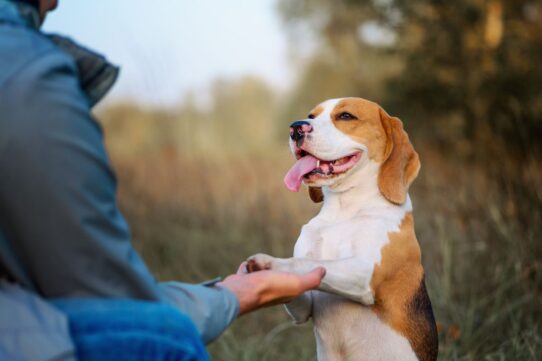As a pet owner, it’s only natural to want to include your four-legged friend in all aspects of your life—including when you add a new puppy to the family. However, if you already have an older dog at home, it’s important to take some extra care when introducing the two. Why? Well, things don’t always go so smoothly.
Dogs generally aren’t too fond of one another, and while there are definitely dogs out there that are super friendly, your senior dog or your puppy may not go along too well when they first meet. As such, it is vital that you know how to introduce the two together safely to ensure the transition between the stranger and good friends between the two dogs happens!
So, with that said, if you’re wondering properly introduce your puppy to your senior dog, here are a few tips that you can follow to make the transition easy:
1. Give Your Senior Dog Some Space
When you first bring the puppy home, let your older dog have some time to adjust. This may mean keeping them in separate rooms or on different levels of the house. You will also want to keep an eye on how they interact when they are together. If there is any fighting or aggression, you will need to separate them and continue to introduce them slowly.
You may need to do this for a few days or even weeks until they are both comfortable with each other. Once they seem to be getting along well, you can start letting them spend more time together and eventually transition to having them share a space.
2. Go Slow with Introductions

When you first introduce two dogs, it’s important to take things slow. Let the dogs sniff each other out and get used to each other’s presence before you start playing together. This will help them feel more comfortable with each other and prevent any potential fights.
Take your time when introducing the dogs and let them get to know each other at their own pace. After a while, they’ll be best friends and will love playing together!
3. Be Aware of Body Language and Vocalization
Dogs communicate through body language, so it’s important to be aware of what each dog is saying. If either dog is showing signs of stress or aggression (e.g., growling, stiffening up, hackles raised), separate them and try again later.
Dogs also communicate through vocalizations, so it’s important to pay attention to the sounds they’re making. If either dog is barking excessively or seems agitated, try to calm them down before continuing.
4. Be Consistent with Rules and Training
It is important to be consistent with rules and training from the start. This will help avoid any jealousy or resentment. If the puppy is not allowed on the couch, make sure your older dog is not allowed either. If you don’t give treats to the small dog, don’t give them to your senior dog.
Resentment and jealousy are very real for dogs, and if they see one get treated better than the other, it can cause some real trouble between the two dogs.
5. Give Each Dog Attention
Giving each dog the attention they need is very important. If you have a senior dog, you may need to spend extra time with them while the puppy is napping or taking them for a walk. This will help keep your senior dog happy and healthy.
And, of course, if your puppy is awake, you should also give it attention, just as you would the senior dog. That way, both dogs are happy and stand a much better chance of becoming good friends with each other.
6. Examine Both Dog’s Health
When bringing a new puppy into the home, you need to make sure that both dogs are healthy. Take your senior dog to the vet for a check-up and make sure that they’re up-to-date on their vaccinations. As for the puppy, you’ll need to take them to the vet as well and get them started on their shots. You should also have them checked for parasites and other health problems.
This is vital to ensure no parasites or health problems affect one another, maximizing the chances that they get along together well.
7. Keep an Eye Out For Problems

Even if you do everything right, there’s always a chance that problems could arise between your two dogs. It’s important to keep an eye out for any signs of trouble so that you can deal with it quickly and efficiently.
Some common signs of trouble include growling, biting, excessive barking, fighting, and urine marking. If you see any of these behaviors, it’s important to take action immediately so that the problem doesn’t escalate out of control.
8. Bring the Dogs to Neutral Territory
If you’re having trouble getting your dogs to get along, it might help to bring them to neutral territory. This could be a friend’s house, a park, or even just another room in your own home.
When they’re in neutral territory, they won’t have the same associations with each other and may be more likely to get along. This can help them form a more positive relationship with each other.
9. Keep a Leash on Both Dogs
If you have two dogs that don’t get along, it’s important to keep a leash on both of them at all times. This will help you keep control of the situation and prevent any fights from breaking out.
You may also want to consider using a double-ended leash so that each dog is attached to one end. This will give you more control over both dogs and help prevent them from getting too close to each other.
10. Seek Professional Help
If you’ve tried all of these tips and your dogs still don’t get along, it may be time to seek professional help. A behaviorist or trainer can assess the situation and come up with a customized plan to help your dogs learn to get along with each other.
Conclusion
As a pet owner, it’s only natural to want to include your four-legged friend in all aspects of your life—including when you add a new puppy to the family. That said, if you already have a senior dog in your home, do follow the tips we’ve shared above. This way, you will ensure that both dogs will learn to like each other, ensuring everyone’s happy in your household.
Puppygram helps make purchasing a healthy puppy easy and quick, offering services to help you select the right puppy and have them delivered to your front door. If you are looking for puppies for sale in Louisville, reach out to us today!




